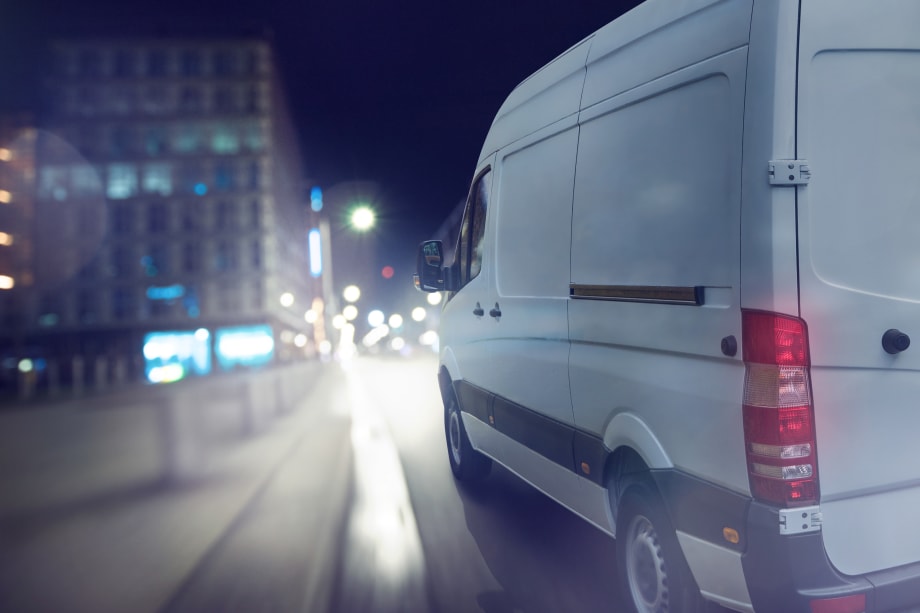Vehicle Tracking Guide for Businesses

What does Vehicle Tracking mean?
Vehicle tracking means monitoring the location of your vehicles or other moving assets. A vehicle tracking system consists of a transmitting device in the vehicle plus a website or app that shows you where the vehicle is on a live map, along with other data.
How does vehicle tracking work?
Vehicle tracking systems use a GPS device fitted in the vehicle. Satellite receivers trace and then transmit the location to your vehicle tracking provider. If you have ever used “find my phone” functionality to locate a smartphone, you have already used this technology.
Most modern vehicle trackers also contain an ‘accelerometer’. The 3-axis accelerometer detects forward and back movement, left and right and up and down.
In a van or car, the accelerometer will detect when the driver accelerates suddenly or brakes sharply. It will also swing when a corner is taken. The device can measure the axis, and therefore detect the severity of harsh cornering, accelerating and sudden braking. The device transmits signals that are decoded by the software.
Within the vehicle tracking software there are various pages of information, which the providers call “reports”. We will talk more about these later.
Who are the primary users of vehicle tracking and why?
Vehicle tracking is used by small businesses, larger businesses with relatively simple fleet tracking needs and by insurance companies.
This article is focused on vehicle tracking for businesses that rely on vehicles to deliver goods or provide a service – mostly van and truck fleets but also company cars.
By showing where a vehicle is located, vehicle tracking provides real-time visibility of mobile operations for improved control, security and customer service. In addition, tracking data is logged to record movements, arrival and departure times, time on site, as well data analytics for producing management reports. Vehicle tracking is used mainly to improve efficiency and productivity, but it also improves safety and security.
Insurance companies offer “black box insurance” for private motorists, which is often cheaper for younger drivers. This is dependent on a vehicle tracker remaining in the insured car. Its data is not visible to the insured car owner, but only to the insurance company that provides it.
Vehicle tracking can give you a bird’s eye view of your fleet at all times, making it quick and easy to manage all your drivers. You can deal with breakdowns or accidents immediately and even check the driver dashcam footage or speeding incidents from your mobile phone.
As a free comparison site, iCompario can help you find the right system for the right price.
What types of tracking devices are there?
To an extent you get what you pay for and the cheapest devices will have limitations.
You need to select a vehicle tracking solution that fits your needs and something that is going to be easy to implement and use. The key is to get the features you need, and not get sold on something that turns out to be too complicated with functionality that you won’t use.
If it is your first venture into vehicle tracking look for something that gets the fundamentals right; proven, accurate, reliable and in an affordable package with no hidden cost surprises.
Self-install vehicle trackers
Self-install vehicle trackers are the cheapest option. They can give GPS location information but cannot monitor driver behaviour. They usually have two wires which you can easily connect to the vehicle battery.
Some people like this option because:
- There’s no time with their vehicle off the road
- They can easily switch the tracker from one vehicle to another if they want to
- It is powered and automatically without any involvement by the driver
- They don’t need driver performance reports
- It’s a very economical option.
The downside is:
- Thieves can easily remove the device and professional vehicle thieves usually know how to do this
- Some drivers switch the device in out of the vehicle to deceive their employer.
Hard-wired device
A professionally installed vehicle tracking device with an accelerometer has at least three wires, but sometimes as many as twelve, to connect to different electrical circuits in the vehicle, depending on what the fleet manager needs.
The main benefits are:
- You can get driver behaviour information
- It is professionally installed so it is tamper-proof
The downside:
- You need an engineer to fit the device so your van will be of the road for about 45 minutes
- This solution costs more than a self-install device.

How do I choose my tracking system?
There are two things to consider; the actual system and who supplies it.
So, it is very important to choose a supplier that is and will remain financially secure; ideally part of a large and long established company, with the resources and financial back-up you need. You normally get into long-term relationships with a vehicle tracking provider to avoid the inconvenience of switching providers, so it makes sense to choose carefully the first time.
Vehicle tracking systems vary in price, accuracy and ease of use. Here are some questions to consider before choosing:
- What is the fee structure? Some people who are new to vehicle tracking do not realise they will have to pay a monthly subscription to use the device as well as the up-front fitting fee.
- Do I own the tracking device? Ask if the up-front fee means you own the device, or if this is just a charge for fitting it.
- Will I get a free replacement if the device stops working?
- How easy is the software? Ease of use is important. Some systems look very slick but they are complex and take a long time to learn. Others may have a more basic look, but be easier to use.
- What data does the mobile app show? Ask about mobile apps, and how much vehicle tracking data you can get from them compared to the browser software.
- Do you support driver ID keys? If more than one driver uses the same van, some systems can incorporate a driver ID key to keep the two drivers’ data separate in the software system. Check this before buying if you need it, because not all systems offer it.
What benefits does live tracking offer?
Being able to see the location of every vehicle in real time, anytime and anywhere provides immediate operational and service customers benefits. The office can see where vehicles are and whether they are on schedule and on route.
Most systems can automatically generate notifications, by email or in the user app to alert fleet managers or customers of expected arrival times.
What is Geofencing?
A geofence is a line on a map, enclosing an area or a specific location of any size. It might be your depot, a congestion charging zone, a low emissions restriction zone, a pre-planned route or a harbour with shipping containers that can carry away stolen vehicles! Other locations can also be mapped such as customer sites, home addresses and low bridges.
When a vehicle enters or leaves the geofenced area, the vehicle tracking system can collect data for later use, or send an immediate alert.
This could let you know about a vehicle leaving your depot outside working hours. It could alert you to a thief or someone using your van and fuel for some work on the side. It could let you know that a driver has deviated off route, or entered a restricted area.
Is vehicle tracking difficult to use?
From day one you’ll get immediate benefits from the built-in features of vehicle tracking.
Most companies find an immediate improvement in driver reliability, simply because they know they are being monitored.
It is easy to improve customer service by checking the location of a driver, so you can immediately answer a question from a customer asking when their delivery or plumber will arrive. Most systems let you enter the destination and then display an estimated time of arrival.
Over time, the more you put in the more you will get out. For example by defining customer site locations you can automatically monitor KPI service levels and reduce invoice queries – because you have indisputable evidence of arrival times and the time spent on site.
I’m very busy and it sounds great but how can I cope with all this data?
You are right, a vehicle tracking system generates huge amounts of data. By itself that data is of little value. That’s why it’s important to choose a system that makes effective use of this data and presents the information you need, simply and clearly, so you can use it to improve your fleet management, cut costs and keep your vehicles safe.
Some vehicle tracking suppliers offer other fleet-related services and have a standard platform for other closely aligned fleet-related data, such as fuel cards.
To make things even easier, some providers condense information down into a simple weekly and monthly report that contains all of the top-line insights you need; very helpful for those short on time.
Can we use vehicle tracking to prevent fuel card misuse?
Vehicle tracking software can integrate with other fleet–related data such as fuel cards.
Some providers can calculate the miles per gallon for each vehicle. For this to work, your drivers must use the same fuel card and never use other payment methods. For some companies this is useful information to start cutting costs.
Linking fuel card data to vehicle tracking data is also useful to identify any fraudulent use of your cards. There is always a possibility that cards are being used inappropriately to pay for fuel put into private vehicles. Fuel fraud alerts allow you to monitor for fuel misuse by cross referencing the location of your vehicles to the location where the fuel card was used.
Even if you don’t have fuel cards and your employees claim a mileage allowance, the vehicle tracking data can be invaluable in spotting false mileage claims.
Vehicle tracking can also allow you to differentiate between business and private journeys making it easier to calculate and reclaim VAT paid on business fuel.
How difficult is vehicle tracking to install and use?
A professional installer should come and fit a device into the vehicle and, if needed, a driver ID reader as well. You’ll need to arrange for vehicles to be available for a couple of hours.
As for the tracking software, it is likely to be a cloud-based system that requires no special software and no installation. Everything is online once security access levels have been set up for each user. The system is immediately accessible and will start receiving vehicle data as soon as trackers are fitted.
Can vehicle tracking improve security?
A vehicle tracking system can trigger an alarm when there is unexpected movement, for example when the driver has not been identified or when it leaves a secure zone such as your depot out of working hours.
Vehicle tracking may not stop theft, but it will allow for quick retrieval of the vehicle.
If the vehicle is only insured for business use, the system can also alert management to unauthorised use out of hours.

What about driver safety?
Duty of care has become increasingly important in recent years and vehicle tracking has an important part to play.
Many insurers are reducing premiums for fleets that are equipped with trackers. The data can also be used to fight a claim in the case of an accident or a fraudulent claim, proving a vehicles’ location and the fact that it was not speeding and was being driven safely.
Importantly, vehicle tracking can improve driving, as systems increasingly monitor how safely someone drives using algorithms that measure everything from harsh braking and acceleration to speeding. It’s important for duty of care and for identifying those requiring additional instruction.
Also remember that your drivers are often the public face of the company; discourteous and unsafe driving will tarnish the reputation of the business.
How can vehicle tracking improve efficiency and productivity?
This is the ultimate benefit for most businesses. Vehicle tracking provides a clear insight into your operational performance; something that was invisible before.
You have an array of actual data which can be compared with your existing ‘pre-planned’ operations.
This includes
- miles travelled
- travelling time
- time on site
- routes taken
- areas covered.
With this added visibility, you can properly access your operational costs and inevitably you’ll be able to make improvements to routes, schedules, resource allocation and many other operational variables.
It’s not uncommon for companies to report 20 percent reductions in mileage and similar gains in productivity; vehicle tracking allows new working practices to be employed such as enabling engineers to work from home rather than start the day at the depot.
We are environmentally conscious, does vehicle tracking provide any benefits?
Yes. Firstly you should be able to reduce CO2 and other harmful emissions by optimising routes to reduce unnecessary mileage. Vehicle tracking data will provide real data on journeys allowing you to re-access planned routes, schedules and territories.
Secondly, fuel consumption can be reduced considerably through improved driving. Vehicle tracking can identify drivers who require additional training or a serious talk! Monthly ‘safest driver’ rankings can provide an incentive for drivers to improve.
What about device and data security?
To ensure uninterrupted data is received from the vehicle tracking device, there are some key features that should be incorporated. These include tamper-proof connections and automated power-loss alerts. This type of notification will send a message as soon as the tracking device is disconnected from a battery or other electric power supply.
What about data security?
Some vehicle tracking suppliers are particularly hot on data security especially if they have customers in the security industry.
So, check that data is stored on secure servers and the company adheres to the highest data protection standards and personal data protection legislation such as GDPR.
You will normally be able to set up login access levels so users are permitted to view their data and their precise level of access with the appropriate login security.
Find the best vehicle tracking solution for your business
Vehicle tracking can give you a bird’s eye view of your fleet at all times, making it quick and easy to manage all your drivers. You can deal with breakdowns or accidents immediately and even check the driver dashcam footage or speeding incidents from your mobile phone.
As a free comparison site, iCompario can help you find the right system for the right price.


